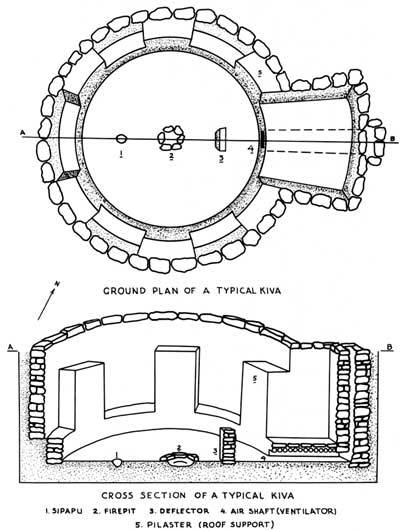|
AZTEC RUINS National Monument |
 |

Man in the San Juan Valley
THE PUEBLOS. (continued) The most obvious change in the Developmental Pueblo Period, as compared to the preceding Basketmaker, was a gradual shift in the type of house construction. The single-unit mud, slab, and jacal semisubterranean house was giving way to the huge multistoried stone and adobe structures, which were to predominate in the Great Pueblo Period 250 years later. In some areas even earlier than A.D. 750 a few people began to build single-room houses above-ground in a contiguous arrangement, often crescent-shaped, forming small villages. The construction varied from district to district. Some houses were quadrangular in form and wholly aboveground, made of adobe and mud with upright, supporting posts; others were still semisubterranean; some even showed the beginnings of true stone masonry.
At this time also, a new type of structure was coming into existence (though a few examples are known from late Basketmaker times). This new structure, the kiva, was simply a modification of, and change in, the use of the old pithouse. A kiva is a ceremonial room and clubhouse for the men, usually constructed underground (or, where aboveground, so clustered in other rooms as to appear belowground in its relation to the surrounding rooms). It is circular like the early pithouses, but normally contains a fireplace, a deflector (to prevent the draft from fanning the fire too much), and a ventilator shaft by which to bring in the fresh air. A "sipapu" (a small hole which supposedly leads to the underworld) was located in the floor on the opposite side of the fire place from the deflector. Usually there was a bench around the inside of the kiva near the floor, which may either have been used as a place on which to store religious objects and other paraphernalia or may have served the functional purpose of strengthening the lower part of the kiva wall. Smaller kivas frequently had pilasters built upon the bench and extending upward a short distance; these supported the cribbed roof structure. Large kivas had four centrally located posts which helped support the roof. Entrance to a kiva was normally gained by means of a ladder through the central smoke hole in the roof.
It is difficult to assign the same dates to this Developmental Pueblo Period in all areas of the San Juan Basin. Culturally some sections seemed to lag behind others; some ideas, concepts, and artifacts spread and were accepted faster than others. Also, certain regions have been much better explored archeologically, and we know more about them.
Unfortunately, the Animas is one of the river valleys in the San Juan drainage which has not been particularly well surveyed or investigated archeologically. Accounts by early settlers, and passing references in some of Morris' reports, indicate that in aboriginal times (certainly during Pueblo times), the valley was no doubt heavily populated. It should have been. Good water is readily available in the river and the climate is healthful; prehistorically, game must have abounded in the nearby foothills and mountains. Settlement and clearing of lands in more recent times have eliminated many of the prehistoric remains, but the higher banks along the river terraces still show low mounds of rubble, obviously man made, with indications of cobble and sandstone walls, which evidently were dwellings of the Pueblo Period.
Best known in this valley area are the cave and open sites that Morris excavated north of Durango and which contained the remains of early Basketmaker peoples already mentioned and the great pueblo of Aztec, near the town of the same name about 15 miles above the confluence of the Animas and San Juan Rivers. As described elsewhere, this latter structure was also excavated by Morris in 1916-21. Without doubt, parts of the valley were more or less continuously occupied from early Basketmaker times until the final abandonment of the Four Corners country about A.D. 1300. Although we have no firm data on which to base conclusions, it would be safe to assume that the Developmental Pueblo Period in the Animas Valley lasted from about A.D. 750 or 800 to 1050 or 1100, and that conditions in the living patterns of the people elsewhere were reflected in the Animas Valley.
As the Developmental Pueblo Period progressed, house arrangements became more complex. The next step seems to have been an extension of the earlier linear or crescent-shaped alinement of contiguous houses by adding on one or more wings, so that the resulting plan was L-shaped or formed a rectangular U. In these cases, the semisubterranean kiva was still retained in the courtyard as a definite religious structure. These types of planned communities are called "unit houses." Most were single storied, though some may have had a second story added on the back tier of rooms.

|

|
|
Last Modified: Sat, Jan 13 2001 10:00:00 am PDT |


